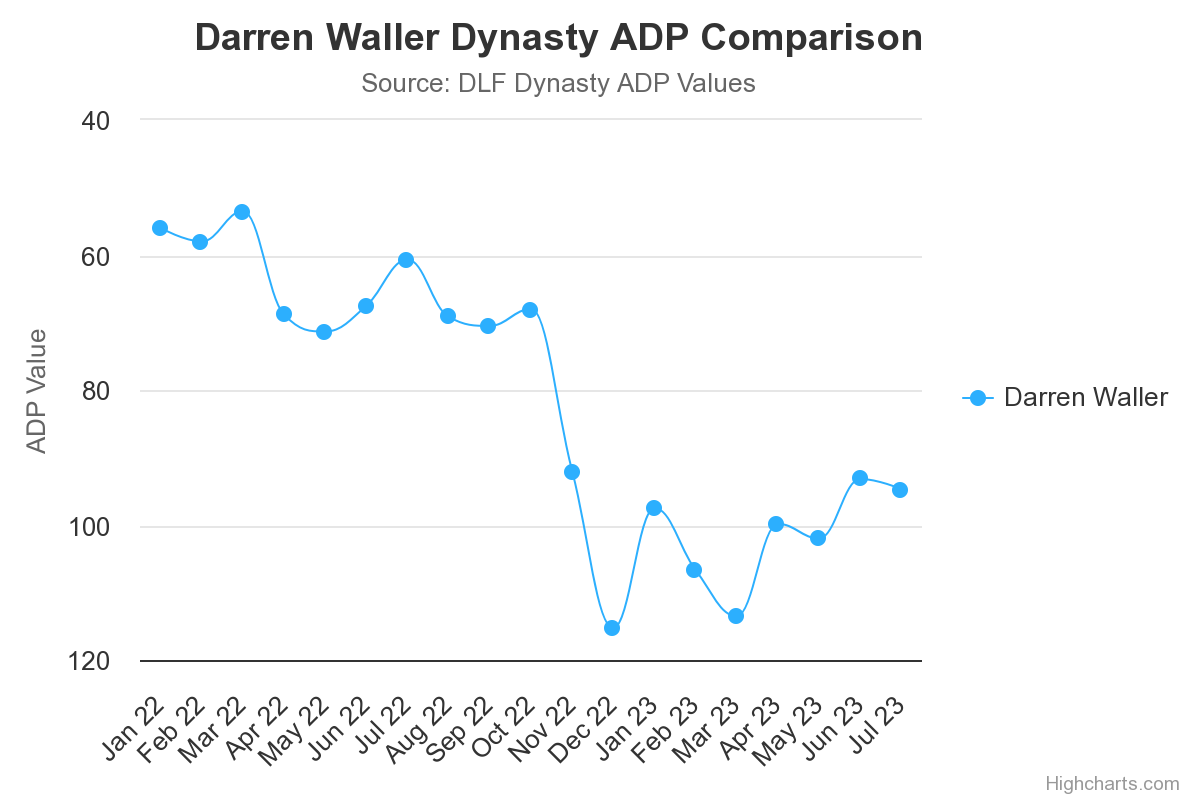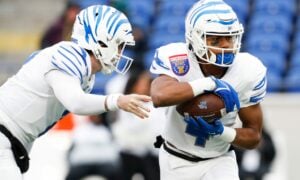Dynasty Fantasy Football: The Simplest Method of Finding a Top-Six Tight End

In 2020 I wrote an article on Noah Fant’s prospects of breaking out in his second season. My research led me on a fact-finding journey to simplify how we look for breakout tight ends, which I’ve arbitrarily defined as finishing in the top six at the position. The TL;DR version of that article is that for the four NFL seasons spanning 2016-2019, a tight end needed to be first or second on their team in total targets and, on average, finish with a 21.07% target share.
Surprise! Volume matters in fantasy football. This certainly isn’t some groundbreaking new metric or way of analyzing the position. Still, when you are on the clock and thinking about selecting a tight end, I hope it will make you think about the player you are considering and their projectable role in the pecking order of the offense.
Since that article was published, three more NFL seasons have come and gone, and we have moved into the era of 18-week seasons. It’s time to update our findings.
| 2020 | ||||||
|---|---|---|---|---|---|---|
| FP | FP/G | Target % | Team Target Rank | TD | ||
| 1 | Travis Kelce | 312.8 | 20.9 | 23.7 | 1 | 11 |
| 2 | Darren Waller | 278.6 | 17.4 | 27.7 | 1 | 9 |
| 3 | Logan Thomas | 176.6 | 11.0 | 19.2 | 2 | 6 |
| 4 | Robert Tonyan | 176.6 | 11.0 | 11.8 | 4 | 11 |
| 5 | TJ Hockenson | 175.3 | 11.0 | 18 | 2 | 6 |
| 6 | Mark Andrews | 170.1 | 12.2 | 22 | 2 | 7 |
| 2021 | ||||||
| FP | FP/G | Target % | Team Target Rank | TD | ||
| 1 | Mark Andrews | 301.1 | 17.7 | 24.7 | 1 | 9 |
| 2 | Travis Kelce | 263.8 | 16.5 | 20.2 | 1 | 9 |
| 3 | Dalton Schultz | 208.8 | 12.3 | 15.8 | 2 | 8 |
| 4 | George Kittle | 199 | 14.2 | 21.9 | 2 | 6 |
| 5 | Zach Ertz | 180.7 | 10.6 | 18.3 | 2 | 5 |
| 6 | Kyle Pitts | 176.6 | 10.4 | 18.3 | 1 | 1 |
| 2022 | ||||||
| FP | FP/G | Target % | Team Target Rank | TD | ||
| 1 | Travis Kelce | 317.3 | 18.6 | 22.6 | 1 | 12 |
| 2 | TJ Hockenson | 216.4 | 12.7 | 19.2 | 2 | 6 |
| 3 | George Kittle | 201.5 | 13.4 | 17.8 | 3 | 11 |
| 4 | Mark Andrews | 190.5 | 12.7 | 25.1 | 1 | 5 |
| 5 | Evan Engram | 176.9 | 10.4 | 16.3 | 3 | 4 |
| 6 | Tyler Higbee | 152 | 9.5 | 19.2 | 1 | 3 |
As I did in the previous article, I must start by honoring Travis Kelce. He has dominated fantasy football, scoring the most fantasy points at the position in six of the last seven seasons, and in the one season he didn’t finish first; Kelce finished second!
To quickly summarize the findings of the 2020 article, out of 24 possible top-six finishes (six spots per season times four seasons), there was only one occasion when a tight end had finished as a top-six fantasy tight end without receiving the most or the second-most targets on his team from 2016-2019. 67% (16) led their team in targets, 29% (7) were second, and just 4% (1) was outside of the top two in targets for their teams.
We get slightly different numbers when we dig into updated data from the last three seasons (2020-2022). Of the 18 total spots in the top six available, 44.4% (8) led their team in targets, 38.9% (7) finished second on their team in targets, 11.1% (2) finished third on their team in targets, and 5.6% (1) finished the season as the fourth-most targeted pass catcher on their team. Furthermore, tight ends who have finished in the top six over the previous three seasons have averaged a 20.1% target share.
Despite a couple more outliers, my hypothesis remains correct three seasons since the original article. Over the past three seasons, 83.3% of the top six scorers at the tight end position have finished first or second on their team in targets. Let’s dig into the outliers who got there without hitting that benchmark.
The one from 2020, and the only one from the past seven seasons to get there as the fourth option, was Robert Tonyan. I think it’s pretty clear how he got there by looking at the touchdown column. His 11 touchdowns in 2020 are tied for the tenth most in a season since 2013. Touchdown efficiency is the easiest and generally most unpredictable way for a low-volume player to reach the top six.
We had two tight ends get there in 2022 without being first or second on their team in targets. Both George Kittle and Evan Engram got there despite being the third most targeted player on their respective teams. In Kittle’s case, it’s easy to spot the touchdowns as the reason. He finished the season on a tear, scoring seven touchdowns over the final four weeks of the regular season, which eclipsed his previous career high of six in an entire season. Kittle’s 11 touchdowns in 2022 was a career-high by nearly double his previous mark set in 2021.
Despite finishing third in targets for Jacksonville, Evan Engram’s path to finishing as TE5 in 2022 is a little tougher to locate. He only scored four touchdowns which was fewer than Cole Kmet, Juwan Johnson, Dawson Knox, Mike Gesicki, and Jordan Akins. So what was special about Engram’s 2022 season? Not much, honestly, outside of target volume, which wasn’t a huge number compared to the Jacksonville wide receivers, but his 98 targets were tied for fifth at the position, his 73 receptions were tied for third, and his 766 yards were fourth-best in the league.
The tight end position as a whole was pretty horrific in 2022 outside of the top four scorers, so Engram’s health (Only the second time in his career he has played an entire season) and target volume relative to the rest of the field pushed him into the top six. To illustrate further how wretched the position was in 2022 outside of the elites, Tyler Higbee’s 152 PPR points in 2022 was the lowest score for a top-six tight end in the past seven seasons by 11 points!
Now let’s combine our two data sets to give us a seven-season sample size. Since 2016, top-six scorers at the tight end position, of which there have been 42 instances, have come from the following target-earning profiles:
- 24 (57.1%) led their team in targets
- 14 (33.3%) finished second on their team in targets
- 3 (7.1%) finished third on their team in targets
- 1 (2.4%) finished fourth on his team in targets.
- Additionally, over that span, a top-six tight end earned, on average, a 20.7% target share.
So how can we make this information actionable? These two articles aimed to make it easy to decipher if a specific tight end has a realistic shot of making a significant impact on your fantasy team in any given season. Hopefully, this study has accomplished that. An overwhelming 90.4% of top-six point scorers at the tight end position finished the season as their offense’s first or second option.
Armed with that information and your encyclopedia-like knowledge of how every tight end in the league generally fits into their offense, you should be able to make a quick decision when on the clock in your drafts. Simply ask yourself: “Is it likely that this tight end will be the first or second option in their offense?” If the answer is no and there are attractive options at another position, you can likely wait to draft the tight end. If it seems like an ambiguous situation and you still want to draft the player, ask yourself: “Is there a path to a high touchdown total?” If so, perhaps they are worth drafting there, but always remember the volatility of predicting touchdowns in the NFL.
There are likely more granular ways to hit slightly better results by bringing in advanced metrics. Still, a 90.4% hit rate is substantial for running through this easy exercise in your head before clicking that draft button or accepting a trade.
You don’t need me to tell you to draft the elite options and probably don’t need me to tell you about the best buy in all of dynasty right now either, but I’m going to anyway. That player is Darren Waller.

His current supporting cast of 42 slot receivers feels a lot like the dearth of receiving talent he played with during his breakout with the Raiders in 2019 and 2020. Waller’s ADP has fallen by nearly three full rounds since this time last year. His value on the trade market is pretty volatile, with several instances of him being moved for a single 2024 second-round pick and plenty of instances where the price was a single 2024 first-round pick. Somewhere between those two price points is probably closer to his actual value, but I’d be comfortable acquiring anywhere within that range.
- 2024 Dynasty Fantasy Football Rookie Drafts: A View from the 1.01 - April 23, 2024
- Two Players To Sell Before The NFL Draft (And One To Buy) - April 17, 2024
- Final Dynasty Rookie Report Card: Wide Receivers, Part Two - February 10, 2024


































































